University Physics I - Classical Mechanics, 2019
University Physics I - Classical Mechanics, 2019
University Physics I - Classical Mechanics, 2019
Create successful ePaper yourself
Turn your PDF publications into a flip-book with our unique Google optimized e-Paper software.
240 CHAPTER 10. GRAVITY<br />
the object would “fall towards the wall,” just like the object considered in Example 9.6.3 (previous<br />
chapter). Unfortunately, while the idea might work for a space station, it would probably be<br />
impractical for a spaceship, since one would need a fairly large R and/or a fairly large rotation rate<br />
to get ω 2 R ≃ g. (On the other hand, probably even something like 1 5g is better than nothing, so<br />
who knows...)<br />
On a fundamental level, the equivalence between a constantly accelerated reference frame, and<br />
an inertial frame with a uniform gravitational field (such as, approximately, the surface of the<br />
earth), was elevated by Einstein to a basic principle of physics, which became the foundation of<br />
his general theory of relativity. This equivalence principle asserts that it is absolutely impossible<br />
to distinguish, by any kind of physics experiment, between the two situations just mentioned: a<br />
constantly accelerated reference frame is postulated to be completely equivalent in every way to an<br />
inertial frame with a uniform gravitational field.<br />
A remarkable consequence of the equivalence principle is that light, despite having technically “zero<br />
rest mass,” must bend its trajectory under the influence of gravity. This can be seen as follows.<br />
Imagine shooting a projectile horizontally inside the rocket in Figure 10.10. Although an inertial<br />
observer, looking from the outside, would see the projectile travel in a straight line, the observer<br />
inside the rocket would see its path bend down, just as for the projectiles we studied back in Chapter<br />
8. This is for the same reason he would see the object fall, relative to him, in Figure 10.10: the<br />
projectile has a constant velocity, so it travels the same distance in every equal time interval, but<br />
the rocket is accelerating, so the distance it travels in equal time intervals is constantly increasing.<br />
In basically the same way, then, a beam of light sent horizontally inside the rocket, and traveling<br />
with constant velocity (and, therefore, in a straight line) in an inertial frame, would be seen as<br />
bending down in the rocket’s reference frame.<br />
However, if the equivalence principle is true, and physical phenomena look the same in a constantly<br />
accelerating frame as in an inertial frame with a constant gravitational field, it follows that light<br />
must also bend its path in the latter system, in much the same way as a projectile would. (I say<br />
“much the same way” because the effect is not just as simple as giving light an “effective mass”;<br />
there are other relativistic effects, such as space contraction and time dilation, that must also be<br />
reckoned with.) This gravitational bending was one of the most important early predictions of<br />
Einstein’s General Relativity theory, and certainly the most spectacular. Since one needs the light<br />
rays to pass vary close to a large mass to get an observable effect, the way the prediction was<br />
verified was by looking at the apparent position of the stars that can be seen close to the edge of<br />
the sun’s disk during a solar eclipse. The slight (apparent) shift in position predicted by Einstein<br />
was observed by Sir Arthur Eddington during the solar eclipse of 1919 (two expeditions were sent<br />
to remote corners of the earth for this purpose), and it was primarily responsible for Einstein’s<br />
sudden fame among the general public of his day.<br />
Today, with modern telescopes, this so-called “gravitational lensing” effect has become an important<br />
tool in astronomy, allowing us to interpret the pictures taken of distant galaxies, which are often


















